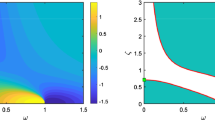Abstract
In this paper we present an application of the algorithm of the cyclic coordinate descent in multidimensional variational problems with constrained speed, the physical motivation of the problem being the optimization of hydrothermal systems. The proof of the convergence of the succession generated by the algorithm was based on the use of an appropriate adaptation of Zangwill’s global theorem of convergence. We have also included an algorithm for the formal construction of the descending succession (the solution of an optimum control problem), the approximation of which we carried out using an adaptation of the Euler method in conjunction with a procedure inspired by the shooting method.
Similar content being viewed by others
References
Mwakabuta, N., Kyaruzi, A.: Short-term scheduling of a hydro-thermal system using linear programming technique. In: Proceedings of the 6th International Power Engineering Conference, pp. 731–736 (2003)
Baskar, S., Subbaraj, P., Rao, M.V.C.: Hybrid evolutionary programming solution to short term hydro thermal scheduling problem. J. Inst. Eng. India, Electr. Eng. Div. 82, 236–242 (2002)
Gil, E., Bustos, J., Rudnick, H.: Short-term hydrothermal generation scheduling model using a genetic algorithm. IEEE Trans. Power Syst. 18(4), 1256–1264 (2003)
Zoumas, C.E., Bakirtzis, A.G., Theocharis, J.B., Petridis, V.: A genetic algorithm solution approach to the hydrothermal coordination problem. IEEE Trans. Power Syst. 19(3), 1356–1364 (2004)
Salam, M.S.: Comparison of Lagrangian relaxation and truncated dynamic programming methods for solving hydrothermal coordination problems. In: Proceedings of International Conference on Intelligent Sensing and Information Processing, pp. 265–270 (2004)
Salam, M.S., Nor, K.M., Hamdan, A.R.: Hydrothermal scheduling based lagrangian relaxation approach to hydrothermal coordination. IEEE Trans. Power Syst. 13(1), 226–235 (1998)
Redondo, N.J., Conejo, A.J.: Short-term hydro-thermal coordination by Lagrangian relaxation: solution of the dual problem. IEEE Trans. Power Syst. 14(1), 89–95 (1999)
Tseng, P., Bertsekas, D.: Relaxation methods for problems with strictly convex costs and linear constraints. Math. Oper. Res. 16(3), 462–481 (1991)
Luo, Z.Q., Tseng, P.: On the convergence of the coordinate descent method for convex differentiable minimization. J. Optim. Theory Appl. 72(1), 7–35 (1992)
Tseng, P.: Convergence of a block coordinate descent method for nondifferentiable minimization. J. Optim. Theory Appl. 109(3), 475–494 (2001)
Rätsch, G., Mika, S., Warmuth, M.: On the convergence of leveraging. In: Dietterich, T.G., Becker, S., Ghahramani, Z. (eds.), Advances in Neural Information Processing Systems 14. MIT, Cambridge, MA (2002)
Rätsch, G., Warmuth, M., Mika, S., Onoda, T., Lemm, S., Müller, K.: Barrier boosting. In: Proceedings of the Thirteenth Annual Conference on Computational Learning Theory, pp. 170–179 (2000)
Chambolle, A., Lions, P.L.: Image recovery via total variation minimization and related problems. Numer. Math. 76(2), 167–188 (1997)
Fan, A., Wells, W., Fisher, J., Çetin, M., Haker, S., Mulkern, R., Tempany, C., Willsky, A.: A unified variational approach to denoising and bias correction in MR. Lecture Notes in Computer Science, vol. 2732, pp. 148–159 (2003)
Bayón, L., Grau, J.M., Suárez, P.M.: A new formulation of the equivalent thermal in optimization of hydrothermal systems. Math. Probl. Eng. 8(3), 181–196 (2002)
Bayón, L., Grau, J.M., Ruiz, M.M., Suárez, P.M.: New developments on equivalent thermal in hydrothermal optimization: an algorithm of approximation. J. Comput. Appl. Math. 175(1), 63–75 (2005)
Santos, M.S., Vigo-Aguiar, J.: Analysis of a numerical dynamic programming algorithm applied to economic models. Econometrica 66(2), 409–426 (1998)
Santos, M.S., Vigo-Aguiar, J.: Error bounds for a numerical solution for dynamic economic models. Appl. Math. Lett. 9(4), 41–45 (1996)
Bayón, L., Grau, J.M., Suárez, P.M.: A necessary condition for broken extremals in problems involving inequality constraints. Archives Inequalities Appl. 1(1), 75–84 (2003)
Zangwill, W.L.: Nonlinear Programming: a Unified Approach. Prentice Hall, New Jersey (1969)
Bayón, L., Grau, J.M., Ruiz, M.M., Suárez, P.M.: Nonsmooth optimization hydrothermal problem. In: Proceedings of the Computational and Mathematical Method on Sciences and Engineering, vol. 1, pp. 116–125 (2004)
Author information
Authors and Affiliations
Corresponding author
Rights and permissions
About this article
Cite this article
Bayón, L., Grau, J.M., Ruiz, M.M. et al. An application of the algorithm of the cyclic coordinate descent in multidimensional optimization problems with constrained speed. Numer Algor 52, 129–149 (2009). https://doi.org/10.1007/s11075-008-9261-0
Received:
Accepted:
Published:
Issue Date:
DOI: https://doi.org/10.1007/s11075-008-9261-0




